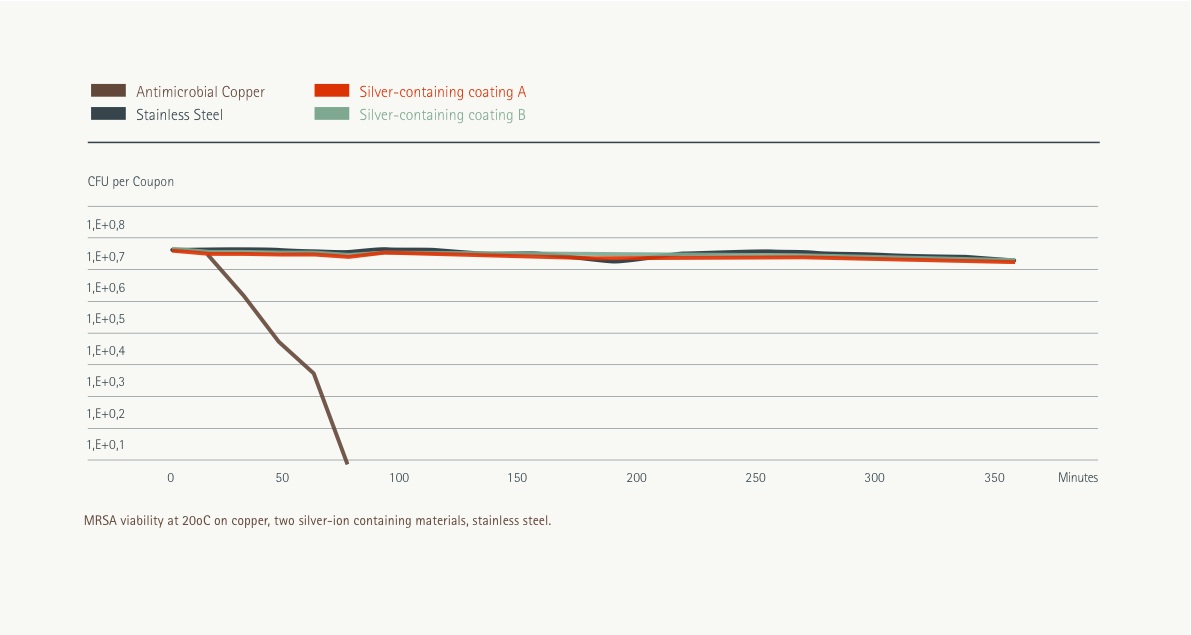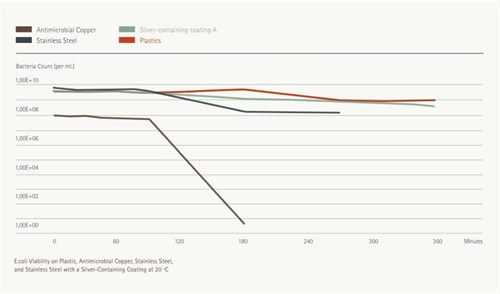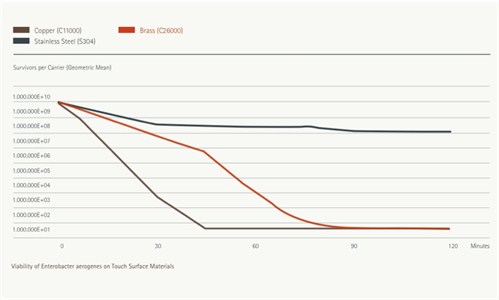Stainless steel may look clean, but deadly bacteria that threaten patient safety can thrive on this material for weeks or even months.
Antimicrobial copper alloys are the first metallic touch surface materials registered by the EPA to continuously kill greater than 99.9% of bacteria* that cause hospital acquired infections and degrade hygiene in hospitals.
Extensive EPA laboratory testing is required to make public health claims.
Antimicrobial copper alloys passed rigorous EPA test protocols and are registered by EPA to make certain public health claims. Efficacy against the 6 registered bacteria* is summarized below.
Methicillin-resistant Staphylococcus aureus (MRSA)
Antimicrobial Copper provides supplemental defense against MRSA. Copper is an excellent material for frequently touched surfaces because of its ability to kill MRSA in between regular cleanings. Click on graph to enlarge
Staphylococcus aureus
Infections caused by Staphylococcus aureus are commonly found in healthcare settings, but are also present in fitness facilities, schools and assisted living facilities. Antimicrobial copper kills >99.9% of this bacterium within two hours in between routine cleanings and touches. The chart below shows the effectiveness of an antimicrobial copper surface. Click on graph to enlarge
Escherichia coli O157:H7
Antimicrobial Copper kills 99.9% of E. coli O157:H7 within two hours adding an additional level of protection to good hygienic practices. The chart below demonstrates that Antimicrobial Copper kills E. coli O157:H7 while stainless steel and plastic have virtually no effect after six hours. Click on graph to enlarge
Figure 2. Viability of E. coli O157:H7 on Plastic, Antimicrobial Copper, Stainless Steel.
Enterobacter aerogenes
The graph below shows Antimicrobial Copper's intrinsic ability to kill this resilient bacterium. Within two hours, more than 99.9% of Enterobacter aerogenes colony forming units is killed on copper and brass, two Antimicrobial Copper alloys, while very little reduction is observed on the stainless steel. Click on graph to enlarge
Figure 3. Viability of Enterobacter aerogenes on Touch Surface Materials
Pseudomonas aeruginosa
Antimicrobial Copper surfaces effectively kill this pathogen while other surface materials are relatively inert. U.S. EPA tests confirmed that Antimicrobial Copper alloys kill more than 99.9% of Pseudomonas aeruginosa within two hours under 3 test protocols.
Vancomycin-Resistant Enterococcus faecalis (VRE)
VRE is resistant to several antibiotics and is easily spread by touch throughout the healthcare environment. Antimicrobial Copper surfaces kill greater than 99.9% of VRE within two hours of exposure providing added protection against this resilient organism.

*Laboratory testing shows that, when cleaned regularly, antimicrobial copper surfaces kill greater than 99.9% of the following bacteria within 2 hours of exposure: MRSA, VRE, Staphylococcus aureus, Enterobacter aerogenes, Pseudomonas aeruginosa, and E. coli O157:H7. Antimicrobial copper surfaces are a supplement to and not a substitute for standard infection control practices and have been shown to reduce microbial contamination, but do not necessarily prevent cross contamination or infections; users must continue to follow all current infection control practices.
All content on this website is intended for the U.S. market and audiences only.




